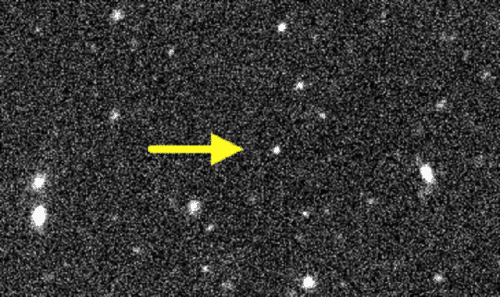The astronomers discovered V774104 by photographing the night sky one hour apart using an instrument known as the Dark Energy Camera of the US National Astronomical Optical Observatory located in Chile. When they turned the photographs into a time-lapse video of the sky, they could see the new body moving against the background of the Sabbath stars.

A new planet may break the record as the most distant dwarf planet in the solar system. The object known as V774104 is in an orbit that brings it up to 12 billion km from the Sun and takes it up to a distance of 67 billion km from the Sun. Even at the peak of its proximity it is 2-3 times more distant than Pluto (Pluto has an extreme elliptical orbit that brings it close even before Neptune-Rahab).
The diameter of V774104 is about half the diameter of Pluto, about 500 km like Pluto it approaches and moves away from the sun during its orbit, but these details of the movement have not yet been calculated. If the size is confirmed, it could be considered a dwarf planet like Pluto.
The astronomers discovered V774104 by photographing the night sky one hour apart using an instrument known as the Dark Energy Camera of the US National Astronomical Optical Observatory located in Chile. When they turned the photographs into a time-lapse video of the sky, they could see the new body moving against the background of the Sabbath stars.
The very discovery raises a hypothesis according to which the inner Oort cloud, the region beyond the Neptune-Rahab orbit, that is 4.5 billion kilometers from the sun and beyond to the most distant objects in the solar system.
This is an important discovery, but apart from the details about the new dwarf planet, it once again raises the question of whether we have found a "super-Earth", a planet with a mass up to 10 times that of the Earth in a distant orbit around the Sun.
Broadly speaking, the solar system is divided into three parts - the four inner planets, Mercury, Venus, Earth and Mars; The four gas giants - Jupiter, Saturn Uranus-Uron and Neptune-Rahab, and beyond them extends the Kuiper belt where dwarf planets such as Pluto, Eris and Sadna revolve. There is a much more distant area - the Oort cloud that extends over vast distances of hundreds of billions of kilometers, the part where the new dwarf planet was discovered and in front of which the SEDNA workshop is already considered to belong to the inner Oort cloud, which until now was considered a "no man's land". Now the scientists estimate that thousands of bodies of this type are sailing in this area, including perhaps bodies larger than the Earth and perhaps even super-Earths - planets up to 10 times the size of the Earth.

6 תגובות
Moshe, it's not unnecessary.. it reflects the style of the site.. did you understand that Yamgiv? 🙂
It's always fun to read your articles.
Just correcting the text "The solar system is broadly divided" I guess the letter Y of "system" is unnecessary.
Hundreds of billions of km? Probably meaning hundreds of millions of km.
fun to read
It's amazing how the picture of our sky changes at such a rapid rate every few years.
There is no doubt that the most amazing thing is the black mass and the fact that the galaxies are accelerating outward, but it is also surprising how much the solar system, as we learned in our childhood, is actually much, much bigger and mainly consists of dozens of counters than "just" nine planets around the sun.
At the edge of the solar system the probability of life is small because the outer stars serve as a protective shell for the inner stars and absorb the impact of asteroids in their place. A droplet (before quanta screamed) is similar to an electron in the outer shell of a metal that can be copied from place to place. In order for conditions similar to the Earth to exist, a huge amount of conditions are required to exist: on the edge of the galaxy, close enough to the sun and far enough from it, massive enough but not too much, having undergone collisions with meteorites carrying water and metals, with a magnetic field that protects from solar radiation.